The OCZ Vertex 3.20 SSD is the latest rendition in the Vertex 3 line and now offers a smaller MLC NAND configuration. Most SSDs, such as the Vertex 3 that we reviewed in 2011, have relied on 25 nanometer (nm) process geometry, but OCZ is taking strides to create production efficiencies and cut costs by moving to 20nm NAND die. However, other than decreased NAND die size, updates are minor. The Vertex 3.20 retains the same controller and processor as its predecessor and produces very similar performance.
The Vertex 3.20 is part of OCZ’s mission under new executive leadership to become more efficient. In the past, OCZ has made an SSD configuration for just about every audience, creating an abundance of SKUs, many with very slim sales. The Vertex 3.20 gets a modest facelift and where the Vertex 3 was once OCZ’s top-performing model, the new model really sits in the mainstream/value market. Of course, previously OCZ had product families targeted to this and the low-end market with the Agility and Solid families, but both have been discontinued in an effort to consolidate the product line into something more sustainable.

Looking at the NAND move specifically, as that’s the focus in this release, we’ve long seen the NAND fabs driving to smaller NAND die. While the on-board packages are the same size, the underlying NAND keeps getting tinier. The shrinking carries with it efficiencies and cost savings through the line and ultimately to the consumer. The cost savings is usually the primary reason to move to a smaller NAND die. In the NAND fab, they’re processing the same 300mm wafer, netting more usable NAND thanks to the drop from 25nm to 20nm lithography. That’s not to say that the 20nm process is new; Intel and Micron 20nm MLC NAND has been in-use with USB drives, SD cards and the like for some time, essentially proving itself there before being put into use in more critical applications like consumer SSDs and eventually up the line to enterprise products. As the 20nm die gets proven out, production at the fabs ramps up, eventually hitting a tipping point for storage vendors like OCZ, making the switch economically viable, even if 25nm NAND is still in production.
Currently, the Vertex 3.20 is available in 120GB and 240GB models, and soon OCZ will release a 480GB version. Street prices for the 120GB and 240GB models are $119.99 and $219.99, respectively, and both come with a three year limited warranty.
OCZ Vertex 3.20 SSD 120GB and 240GB Specifications
- SandForce SF-2281 processor
- Interface: SATA 6Gbps
- 2.5" Form Factor
- Max Read – up to 550MB/s (120GB and 240GB versions)
- Max Write – up to 520 MB/s (120GB and 240GB versions)
- Random Read 4KB: 20,000 IOPS (120GB) 35,000 IOPS (240GB)
- Random Write 4KB: 40,000 IOPS (120 GB) 65,000 IOPS (240GB)
- Native TRIM support
- Seek Time: .1ms
- Dimensions: 99.8 x 69.63 x 9.3mm
- Weight: 83g
- Operating Temp: 0°C ~ 55°C
- Storage Temp: -45°C ~ 85°C
- Low Power Consumption: 2.15W Active, 0.55W Idle
- Shock Resistant up to 1500G/0.5ms
Design and Build
Aside from a new sticker labeling the drive, the new OCZ Vertex 3.20 looks similar to the rest of the Vertex models we’ve reviewed in the previous years. The branding is prominent with OCZ and Vertex 3.20 in the largest font and ocztechnology.com also advertised. The top of the case has a substantial, enduring quality and looks finger-print-free.
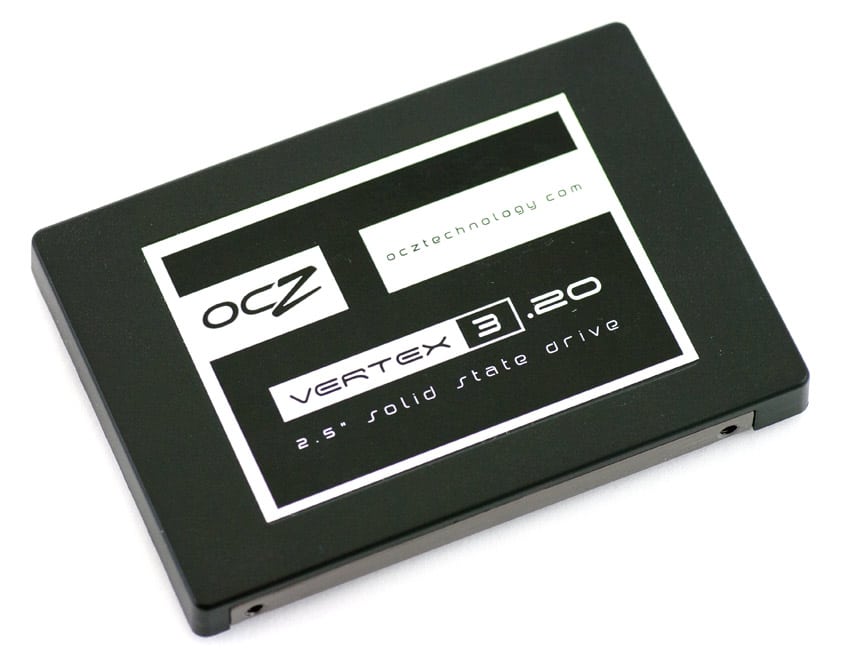
The underside is a nice solid metal. This is where users will find the unit’s simple barcode sticker that also provides information about the drive’s model.
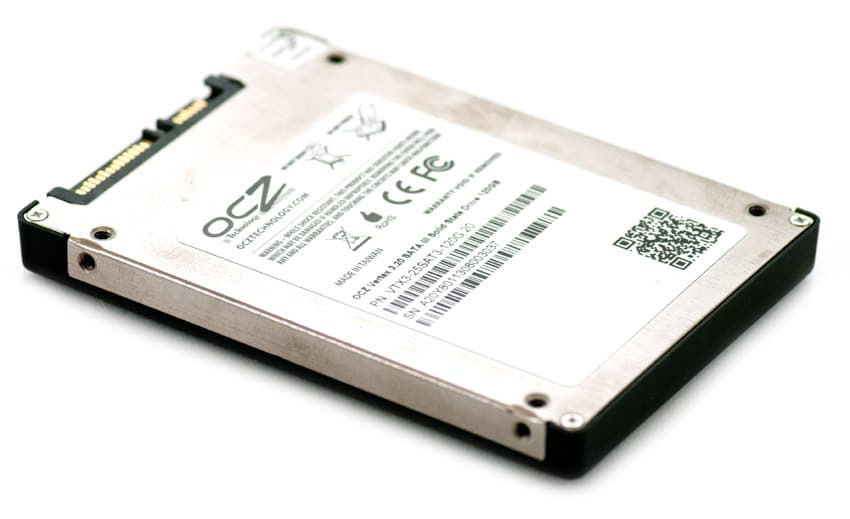
The side profile is standard and basic with screw holes to keep the drive properly mounted both horizontally and vertically. Note that OCZ keeps the standard 9.5mm drive height, instead of opting to shrink the design to compete in the 7mm ultrabook space.
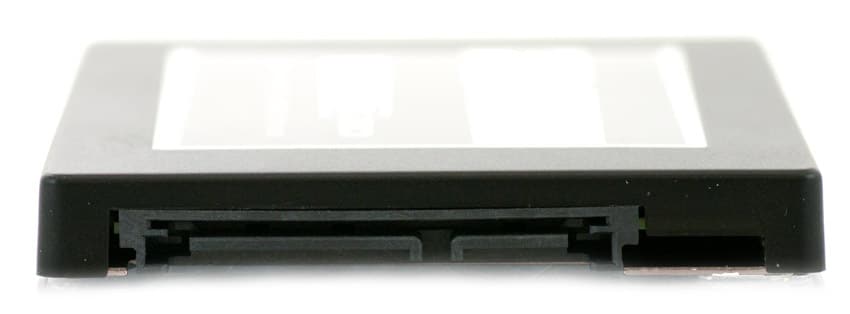
On the front of the drive are the standard SATA power and data connectors.
Disassembly
Opening up the OCZ Vertex 3.20 is very easy by removing four screws and breaking one warranty-voiding sticker. The layout inside the drive has changed slightly compared to previous versions, with the NAND chips aligned on a different axis.
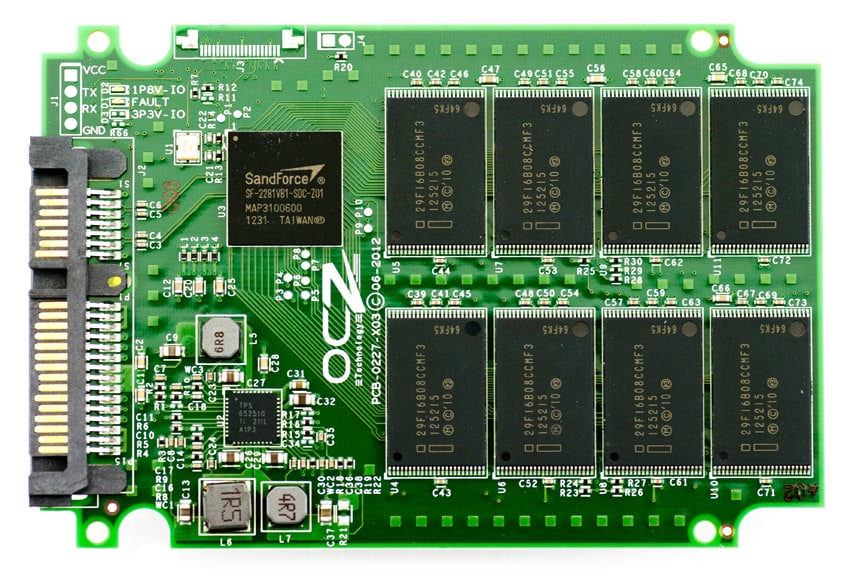
Our 240GB Vertex 3.20 includes sixteen 20nm 16GB Intel 29F16808CCMF3 NAND dies, all routed to the SandForce SF-2281VB1-SDC-ZO1 controller displayed front and center. The circuit board layout is very clean and even.
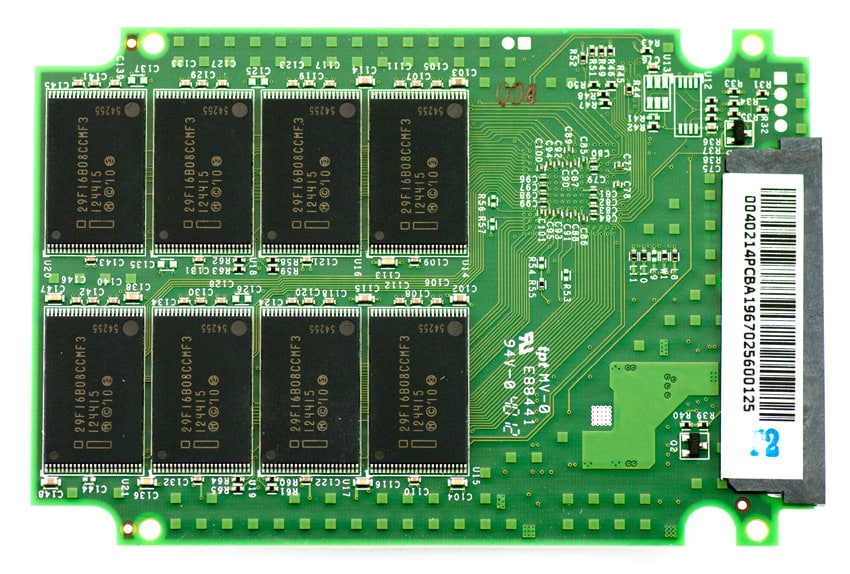
Consumer Synthetic Benchmarks
All consumer SSD benchmarks are conducted with the StorageReview Consumer Testing Platform. The comparables used for this review include:
- OCZ Vertex 3 (120GB, SandForce SF-2281, Intel 25nm MLC NAND, SATA)
- OCZ Vertex 3 (240GB, SandForce SF-2281, Intel 25nm MLC NAND, SATA)
- OCZ Vertex 3.20 (120GB, SandForce SF-2281, Intel 20nm MLC NAND, SATA)
- OCZ Vertex 3.20 (240GB, SandForce SF-2281, Intel 20nm MLC NAND, SATA)
All IOMeter figures are represented as binary figures for MB/s speeds.
In our first benchmark where we test straight line sequential performance. We measured read speeds of the 240GB Vertex 3.20 at 496MB/s with repeating data and 492MB/s with random data. Write speeds measured 459MB/s with repeating data and 316MB/s with random data. Comparing the Vertex 3 to the new Vertex 3.20, there wasn’t as much of a difference between the 240GB model as there was with the 120GB which took a bigger transfer speed hit.
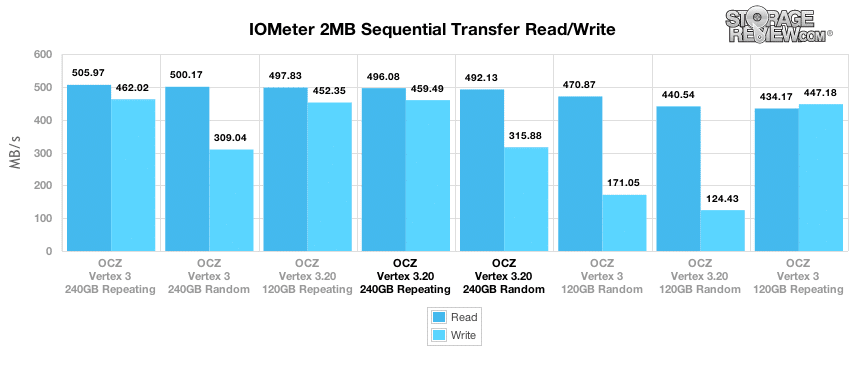
Switching from sequential to randomized large-block transfers, we measured the performance of the 240GB Vertex 3.20 as having a read speed of 496MB/s with repeating data and a speed of 482MB/s with random data. Write speeds measured 459MB/s with repeating data and dropped to 316MB/s with randomized data. With the 240GB capacity, performance actually improved over the 25nm model, although the 120GB Vertex 3.20 actually lost some steam.
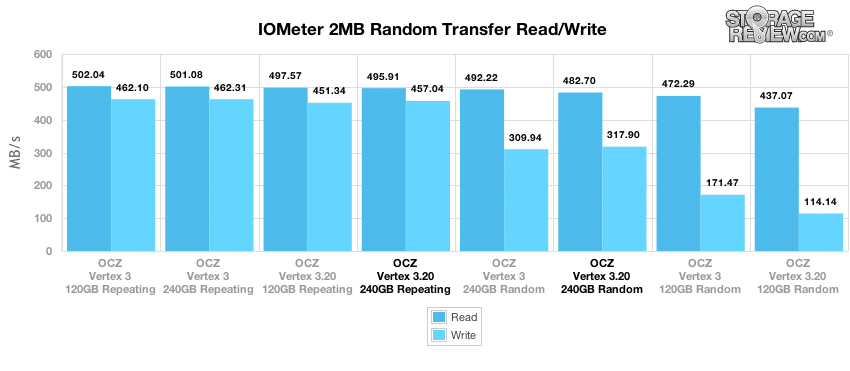
Moving to a smaller transfer size of 4K, we measure the I/O speed of each SSD at a queue depth of 1. With this small transfer size, the newer 20nm Vertex 3.20s both showed slower performance than their 25nm counterparts.
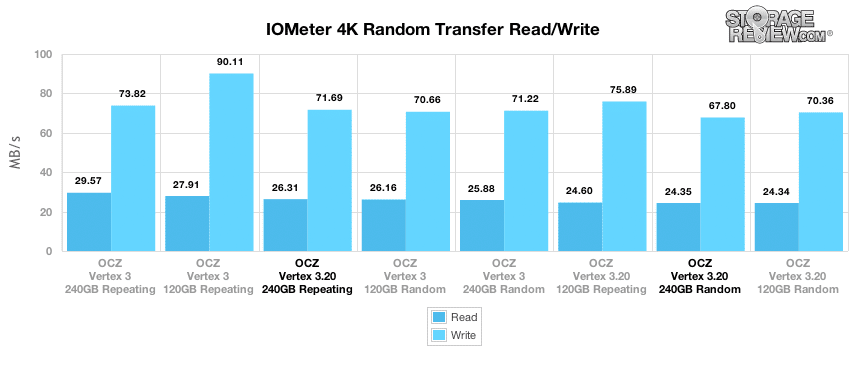
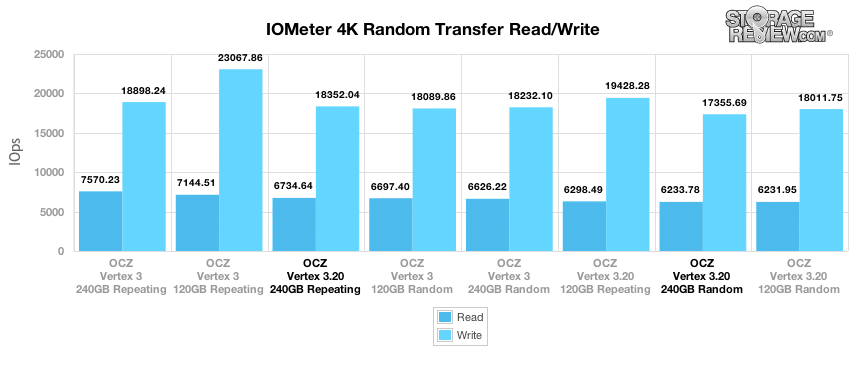
While our first 4K test showed QD1 performance, our next section scales the load from 1 to a peak of 64. Comparing the 25nm Vertex 3 models versus the 20nm Vertex 3.20 models, the 20nm versions both showed lower random I/O speeds across the board, although the 120GB model suffered the biggest loses in read speed.
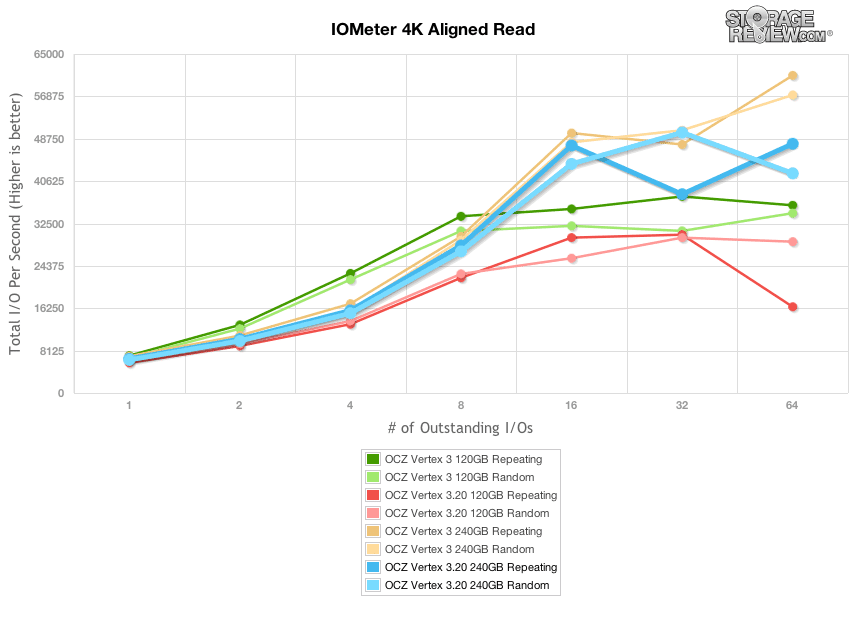
Comparing the write performance of the 25nm vs 20nm models, the 240GB capacity stayed roughly on par, while the 120GB model slowed dramatically as load increased.
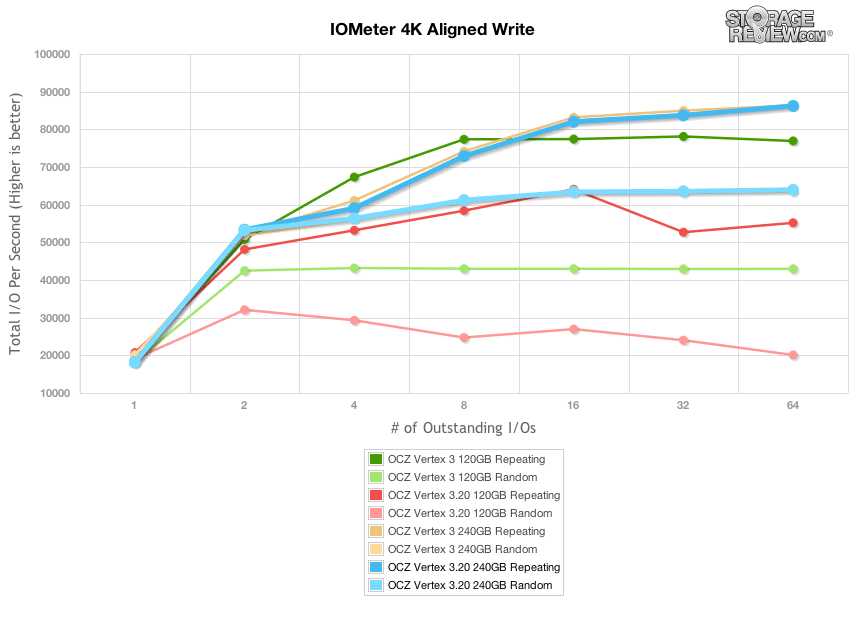
Expanding our QD1 4K test, we look at write latency of each SSD. Lower numbers are better, since it means less wait time for activity to process. Max latency is also important, although that number can change as the NAND wears over time. The OCZ Vertex 3.20s came in with latency at the middle of the pack with repeating data and towards the bottom of the pack with incompressible data. We measured an average latency of 0.0540ms from the 240GB Vertex 3.20 with a peak latency of 10.64ms with repeating data.
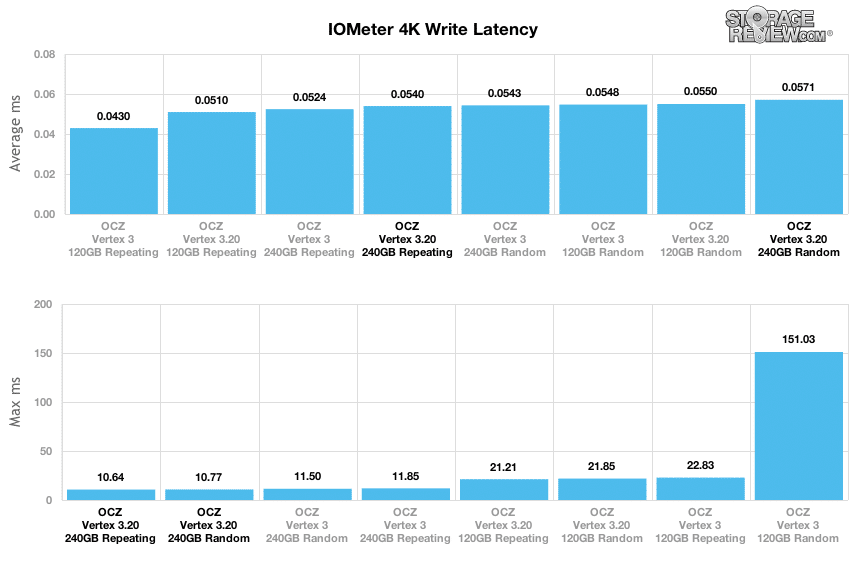
Our last series of synthetic benchmarks compare the hard drives in a series of server mixed-workloads with a queue depth of ranging from 1 to 128. Each of our server profile tests has a strong preference towards read activity, ranging from 67% read with our database profile to 100% read in our web server profile. In all of our mixed workloads the 120GB and 240GB OCZ Vertex 3.20s came in below their 25nm counterparts with both repeating and random data.
The first is our database profile, with a 67% read and 33% write workload mix primarily centered on 8K transfer sizes
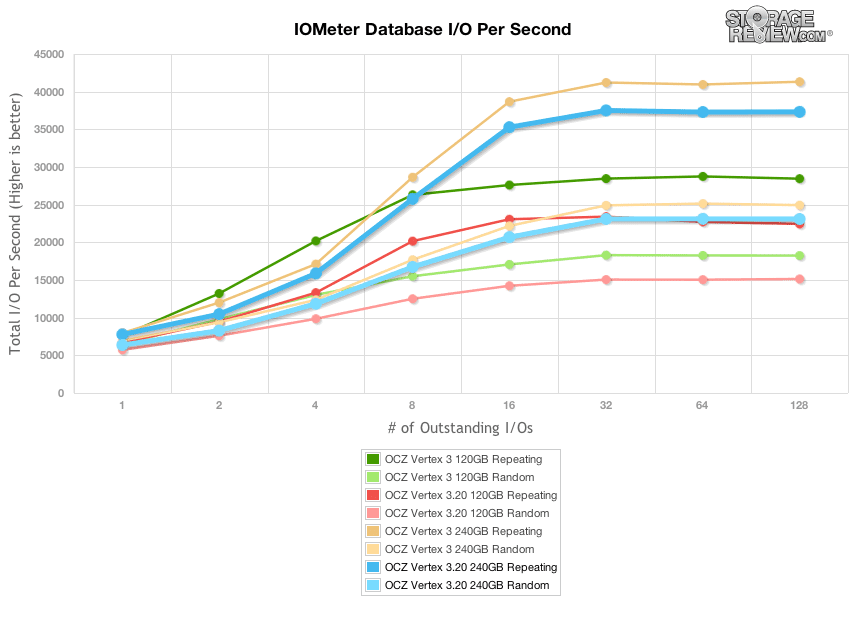
The next profile looks at a file server, with 80% read and 20% write workload spread out over multiple transfer sizes ranging from 512-byte to 64KB.
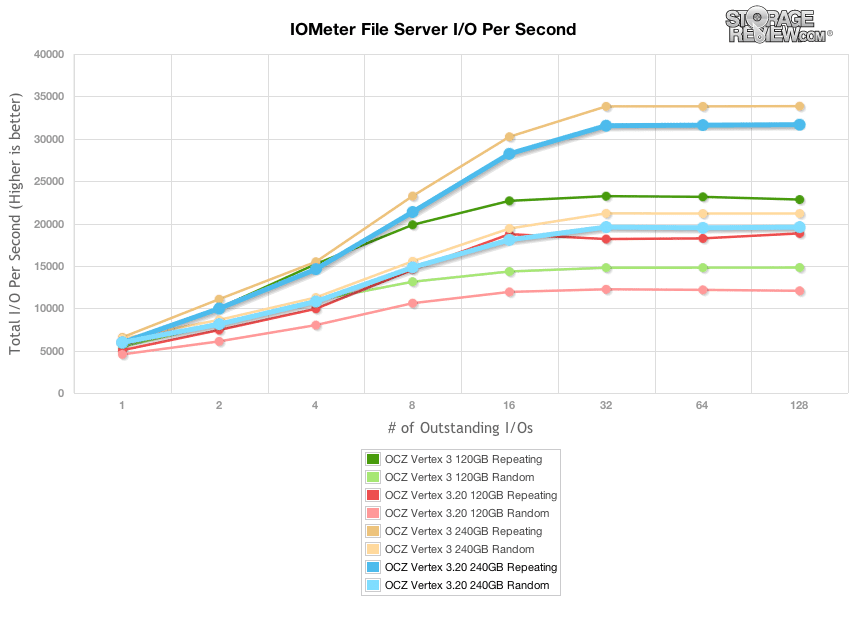
Our web server profile is read-only with a spread of transfer sizes from 512-byte to 512KB.
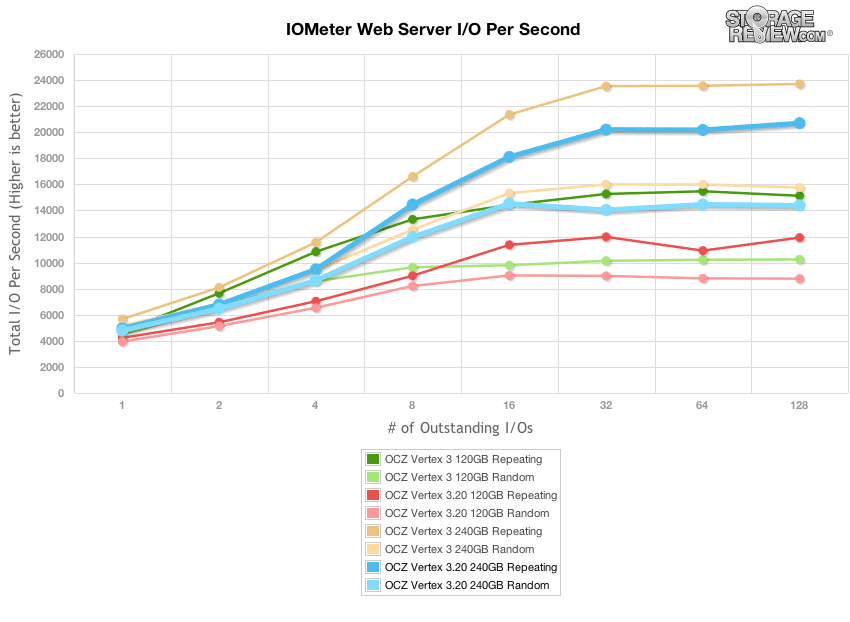
The last profile looks at a workstation, with a 20% write and 80% read mixture using 8K transfers.
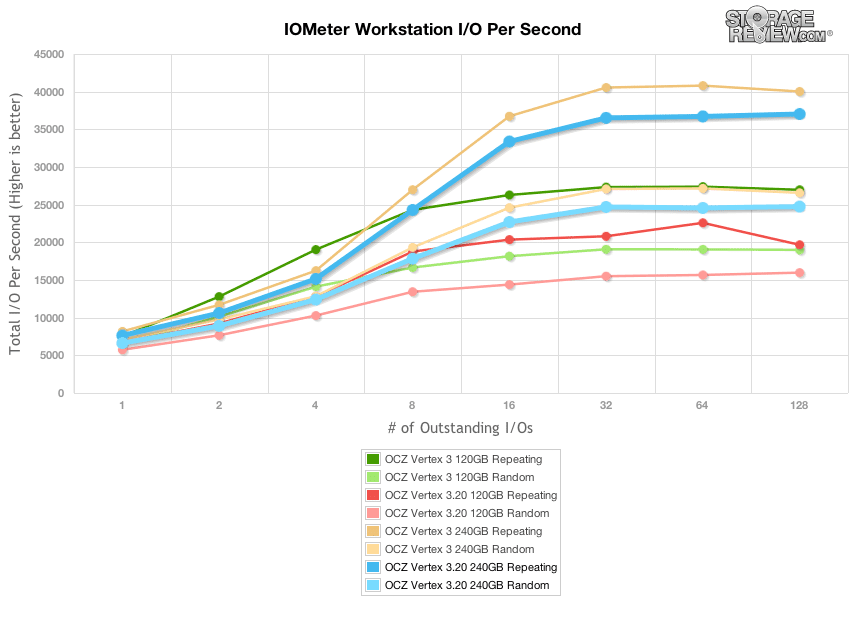
Consumer Real-World Benchmarks
For the average consumer, trying to translate random 4K write speeds into an everyday situation is pretty difficult. It helps when comparing drives in every setting possible, but it doesn’t exactly work out into faster everyday usage or better game loading times. For this reason we turned to our StorageMark 2010 traces, which include HTPC, Productivity, and Gaming traces to help readers find out how a drive might rank under their conditions.
The first real-life test is our HTPC scenario. In this test we include: playing one 720P HD movie in Media Player Classic, one 480P SD movie playing in VLC, three movies downloading simultaneously through iTunes, and one 1080i HDTV stream being recorded through Windows Media Center over a 15 minute period. Higher IOps and MB/s rates with lower latency times are preferred. In this trace we recorded 2,986MB being written to the drive and 1,924MB being read. Our second real-life test covers disk activity in a productivity scenario. For all intents and purposes, this test shows drive performance under normal daily activity for most users. This test includes: a three hour period operating in an office productivity environment with 32-bit Vista running Outlook 2007 connected to an Exchange server, web browsing using Chrome and IE8, editing files within Office 2007, viewing PDFs in Adobe Reader, and an hour of local music playback with two hours of additional online music via Pandora. In this trace we recorded 4,830MB being written to the drive and 2,758MB being read.
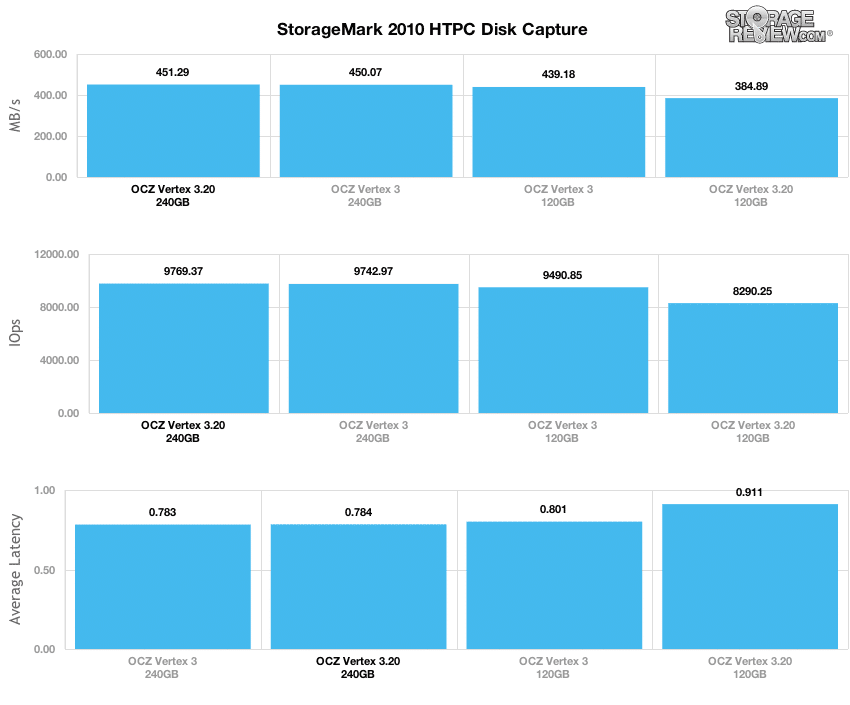
In our HTPC trace, the 240GB Vertex 3 and Vertex 3.20 both offered roughly the same level of performance with the 20nm model having a slight edge. The 120GB Vertex 3.20 dropped in performance, offering a transfer speed of 384MB/s versus 439MB/s from the 25nm model.
Our second real-life test covers disk activity in a productivity scenario. For all intents and purposes this test shows drive performance under normal daily activity for most users. This test includes: a three hour period operating in an office productivity environment with 32-bit Vista running Outlook 2007 connected to an Exchange server, web browsing using Chrome and IE8, editing files within Office 2007, viewing PDFs in Adobe Reader, and an hour of local music playback with two hours of additional online music via Pandora. In this trace we recorded 4,830MB being written to the drive and 2,758MB being read.
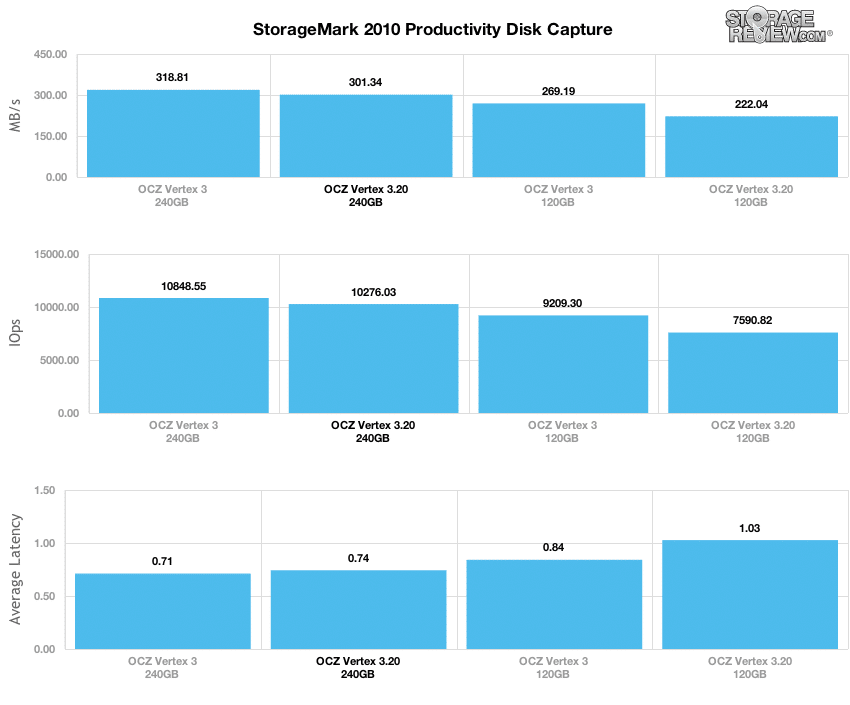
In our Productivity trace the Vertex 3.20 slipped in performance slightly for the 240GB model, but the gap widened when comparing the 120GB version. The 240GB 3.20 slipped 5.5% while the 120GB model lowered by 17.5%.
Our third real-life test covers disk activity in a gaming environment. Unlike the HTPC or Productivity trace, this one relies heavily on the read performance of a drive. To give a simple breakdown of read/write percentages, the HTPC test is 64% write, 36% read, the Productivity test is 59% write and 41% read, while the gaming trace is 6% write and 94% read. The test consists of a Windows 7 Ultimate 64-bit system pre-configured with Steam, with Grand Theft Auto 4, Left 4 Dead 2, and Mass Effect 2 already downloaded and installed. The trace captures the heavy read activity of each game loading from the start, as well as textures as the game progresses. In this trace we recorded 426MB being written to the drive and 7,235MB being read.
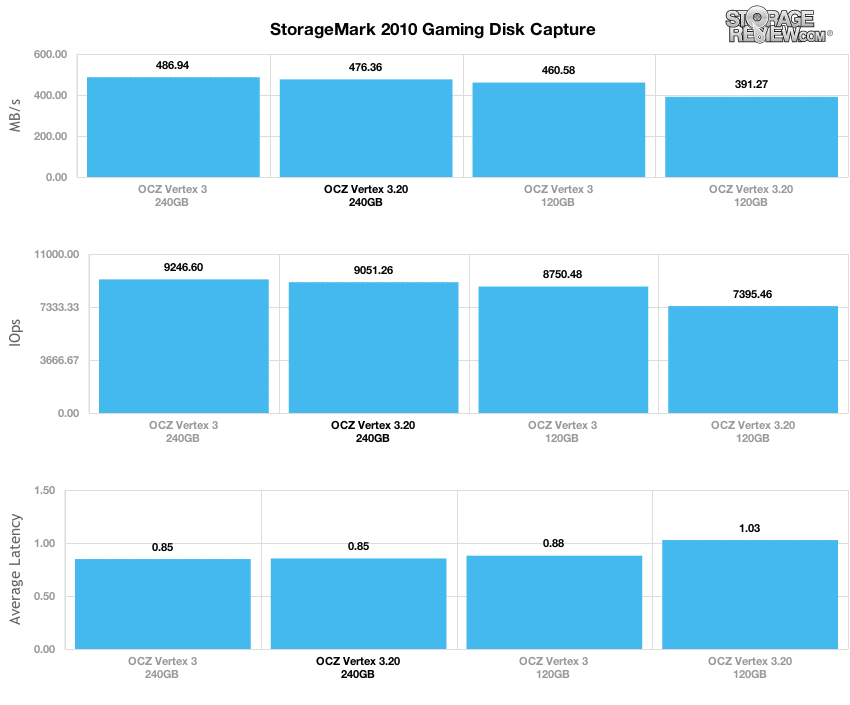
In our read-heavy Gaming trace, the 240GB Vertex 3.20 dropped 2.2% compared to the 25nm model, while the 120GB Vertex 3.20 came down by 15%.
Power Consumption
As SSDs spend much of their time in the idle state, low idle power consumption is a key factor in overall SSD power management. The new 20nm Vertex 3.20 both offered lower idle power draw than their 25nm counterparts, although that’s where the similarities ended.
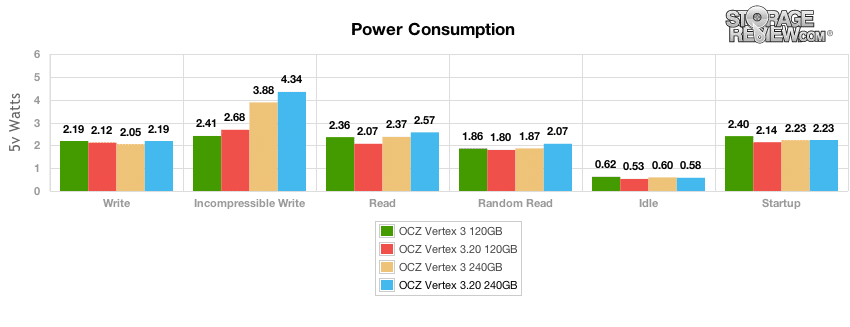
Comparing power consumption during drive activity, the 120GB Vertex 3.20 offered better power consumption across the board, with lower write usage with repeating and incompressible data, read and random 4k read transfers, as well as startup power needed. The 240GB Vertex 3.20 on the other hand used slightly more power in all areas except startup requirements.
Conclusion
As discussed above, OCZ moves to the smaller NAND die in the Vertex 3.20. The shrinking NAND generally carries with it a performance delta which can actually cut either way. Early on in a die shrink process, it tends to be a negative change. However in later generations of that same NAND die size, we often see changes in things like page size and interface speed to show material performance gains. In this case, it looks like the particular NAND from Intel used in this drive didn’t get material updates, so performance drops slightly compared to the 25nm NAND used in the prior Vertex 3. Of course, as the Vertex 3.20 picks up as OCZ’s mainstream consumer SSD offering, the issue of performance loss is somewhat mitigated by its new market positioning, while production efficiencies create an applaudable price drop.
The Vertex 3.20 line yields similar yet lower performance results than the respective Vertex 3 models. The 240GB Vertex 3 and 3.20 in particular were closer in most of the performance testing, though the Vertex 3 kept eeking out victories. In the 120GB models, the results were more prominent and the Vertex 3.20 was separated from the higher-performing Vertex 3. In real-world testing, the Vertex 3.20 drives competed better and the 240GB led in the HTPC trace.
Overall, consolidating the lines and gearing them more toward the mainstream market makes sense for OCZ. They will undoubtedly save money by cutting less popular models, and their new 20nm NAND die configuration will allow them to save even more. Savings for the company will be savings for the consumer, which users can see in the prices for the Vertex 3.20 and will continue to see down the road.
Pros
- Cost Savings over standard Vertex 3
- 240GB Vertex 3.20 shows performance increases over 25nm V3 in some areas
Cons
- Performance decrease in all mixed workloads versus Vertex 3
- 120GB Vertex 3.20 couldn’t match performance of 120GB Vertex 3
Bottom Line
The Vertex 3.20 embodies OCZ’s shift to become more efficient both in production technology and in streamlining their product availability as they move forward. The line is a solid entry into the mainstream market.
OCZ Vertex 3.20 at Amazon.com



 Amazon
Amazon